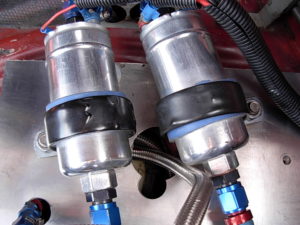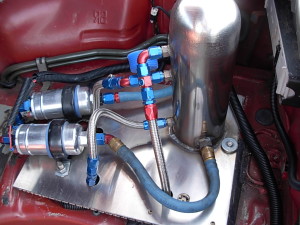When I decided to go all out with the modifications on my R32 GT-R one of the first things I needed to do was to was get a fuel system made. The standard in tank pump wasn’t going to cut it and I didn’t want fuel starvation to be a limiting factor for making power.
Fuel System of Choice
Trolling the forums in the early 2000’s the setup of choice was a surge tank and a Bosch pump, or two, pumping fuel to the engine. Initially I wanted to build my GT-R to have around 400 rear wheel kilowatts so a surge tank and one Bosch 044 pump was going to be more than enough.
Single fuel pump setup
I purchased an aluminium surge tank with one outlet for an external pump from Vanel industries; a great fabricator back in the day that did a lot of work for older generation V8 cars.
Their welds were a work of art and their prices at the time were well below eBay garbage. If memory serves me correct I paid about $180 when the cheap crap on eBay was pushing $300.
I bought the one Bosch 044 pump and lengths of hoses and fittings and put the single pump fuel system together. The setup was that the intank pump sends fuel to the surge tank and the 044 pump sends the fuel to the standard metal fuel lines running to the engine.
The single pump setup was placed in the boot on the side where you can access the intank pump. This made is easy to run the fuel feed and return hoses.
I ran this setup for about 3 months then when the decision was made to take the car off the road and do a full build I decided to rethink my fuel setup.
Duel fuel pump setup
 We got a price from a freelance fabricator to do the fuel system and I had a quote for $1500 which included a surge tank a plate to hold the pumps and that was it. I was shocked! The bizarre thing was people were willing to pay it back then. Since my brother had some fabricating knowledge we decided to do it ourselves.
We got a price from a freelance fabricator to do the fuel system and I had a quote for $1500 which included a surge tank a plate to hold the pumps and that was it. I was shocked! The bizarre thing was people were willing to pay it back then. Since my brother had some fabricating knowledge we decided to do it ourselves.
I went to a local metal recycler and bought huge lengths of stainless steel 4” tubing. In total I bought about 4 meters of it. My intention of buying this large length was to make a custom exhaust, instead I used lengths to build a surge tank as well.
Fabricating the surge tank
- We used a 30cm length of 4” stainless
- Drilled two holes few centimeters from the bottom, enough for the fitting to sit flush with the bottom of the length of stainless and the backing plate.
- Drilled 3 holes evenly spaced horizontally down the length of tube.
- Where the holes were drilled fittings were welded.
- The top cover was welded and then I deburred around all welds to clean things up.
- Finally the backing or bottom plate was welded
Each 044 fuel pump sent fuel directly to my HKS dual entry fuel rail via -8 lines that I ran under the car directly to the engine. This made the standard metal lines redundant.
The standard lines were too small and I felt they would have been too much of a restriction. Running the much larger lines from the pump directly to each end of the fuel rail ensure a lot of fuel was available for consumption.
Fuel cell setup
I wanted to take the modifications to my R32 GT-R to another level. It was crazy but I wanted my GT-R to compete with performance workshops and I was set on getting my GT-R in the top 10 fastest GT-R’s in Australia. In the early 2000’s if you were running quarter miles in the low 10’s then you were easily on the list. I was hoping to hit a 9!
All my modifications was geared towards a 9 second quarter mile pass. I removed my fuel tank and decided to go with a fuel cell in the boot of the car just to trim some weight. Instead of the standard 60L tank that sat outside the car I had a 30L tank that sat in the boot.
I ran two different tanks during this time of insanity. First was a stainless 35L tank without baffles; so like the standard tank the fuel would move side to side on cornering when I would do track work. It was then I decided that I needed a more serious fuel cell with baffles.
I purchased a competition 30L fuel cell with compartments to prevent fuel from moving side to side, commonly referred to as baffles.
These fuel tanks were a pain in the ass as I didn’t have anyway of knowing how much fuel was in the tank. After all, the sender was disconnected as I wasn’t using the standard intank fuel pump. This caused me so much issues that only after a month of having this setup I removed it and put the standard tank back in.
My planned fuel system
Now that my car is coming back together it’s time for me to think about the new fuel system that I will be running. Seeing now that e85 is so readily available and the fact that people are pulling massive power figures on it, is definitely the way to go.
My brother will be fabricating a new surge tank that will sit under the car and run a couple of Walbro e85 pumps. This is the setup we will run while we use the Garrett 2860-9 combo.
When we move on to the single turbo setup, I hope to have a drop tank custom made with an inbuilt surge tank and a section to house the pumps. Not only will the car look good with the drop tank but also make things a lot neater having everything tucked away.
But my future plans are a little while away as the main focus for now is getting the car back on the road.


